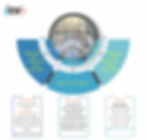Prone Position in ARDS
- Mazen Kherallah
- Apr 10, 2022
- 3 min read
Updated: Oct 7, 2022

Some 60-75% of patients with ARDS have significantly improved oxygenation when turned from supine to prone position. Mortality is also improved in ARDS patients with PaO2/FiO2 <150. Possible noted mechanisms for the improvement are:
Due to the shape of the thorax and the location and weight of the heart, there is a higher percentage of lung volume in the dorsal lung compared to the ventral lung. In the supine position, there is the recruitment of the ventral lung and de-recruitment of the dorsal lung. In the prone position, this reverses and there is the recruitment of the dorsal lung and de-recruitment of the ventral lung. Improvement of oxygenation occurs when recruitment of the dorsal lung exceeds the de-recruitment of the ventral sector, allowing better recruitment overall.
Prone positioning improves heterogeneity of the lung, causes more a homogeneous distribution of the volume, and reduces regional lung strain. It also decreases chest wall compliance, increases functional residual capacity (FRC), and improves diaphragmatic excursion. Higher PEEP may be less likely to contribute to regional hyperinflation with proning.
There is less over-distension in non-dependent lung regions and less cyclical airspace opening and closing in dependent regions; the primary causes of ventilator-induced lung injury.
Prolonged proning (18 h) may lead to the normalization of right ventricle function (acute cor pulmonale) as a result of improvement of hypoxemia, hypercapnia, high driving pressure and plateau pressure.

Multiple studies were performed before 2013 that established the groundwork for the most recent trial of prone position in moderate-severe ARDS by Guerin and colleagues. 28-day mortality was 16% in the prone group compared to 33% in the supine group (p < 0.001; hazard ratio for death with the prone position was 0.39 (95% confidence interval (CI) 0.25–0.63) in a total of 466 patients enrolled in the PROSEVA trial [1].
A meta-analysis examining the impact of the prone position published by Munshi et al in 2017 studied eight RCTs with 2129 patients over 12 years. A prone position was associated with a mortality benefit only when extended for 12 hours per day and in moderate to severe cases of ARDS [RR 0.74 (95% CI 0.56–0.99)] [2]. The analysis showed that the prone position consistently benefitted the more hypoxemic subset of patients with ARDS. However, given the lack of granularity of the pooled data, an evaluation of the specific PaO2/FiO2 threshold of 150 mmHg was not feasible. A trial in mild to moderate cases is underway in France to evaluate the PaO2/FiO2 threshold at which prone position is beneficial.
The 2017 American Thoracic Society/European Society of Intensive Care Medicine/Society of Critical Care Medicine clinical guidelines for mechanical ventilation in adult patients with ARDS strongly recommended that patients with severe ARDS receive prone positioning for more than 12 h per day. The 2019 guidelines of the French Society of Intensive Care Medicine (SRLF) for ARDS management strongly recommended the implementation of a prone position in ARDS patients with a PaO2/FiO2 ratio below 150 mmHg.
The improvement in oxygenation is rapid and often substantial enough to allow reductions in FiO2 or level of PEEP. The prone position is safe, with appropriate precautions to secure all tubes and lines, and does not require special equipment. The improvement in oxygenation may persist after the patient is returned to the supine position and may occur on repeat trials in patients who did not respond initially.
REFERENCES:
1. Guérin C, Reignier J, Richard JC, Beuret P, Gacouin A, Boulain T, Mercier E, Badet M, Mercat A, Baudin O, Clavel M, Chatellier D, Jaber S, Rosselli S, Mancebo J, Sirodot M, Hilbert G, Bengler C, Richecoeur J, Gainnier M, Bayle F, Bourdin G, Leray V, Girard R, Baboi L, Ayzac L; PROSEVA Study Group. Prone positioning in severe acute respiratory distress syndrome. N Engl J Med. 2013 Jun 6;368(23):2159-68. doi: 10.1056/NEJMoa1214103. Epub 2013 May 20. PMID: 23688302.
2. Munshi L, Del Sorbo L, Adhikari NKJ, Hodgson CL, Wunsch H, Meade MO, Uleryk E, Mancebo J, Pesenti A, Ranieri VM, Fan E. Prone Position for Acute Respiratory Distress Syndrome. A Systematic Review and Meta-Analysis. Ann Am Thorac Soc. 2017 Oct;14(Supplement_4):S280-S288. doi: 10.1513/AnnalsATS.201704-343OT. PMID: 29068269.

